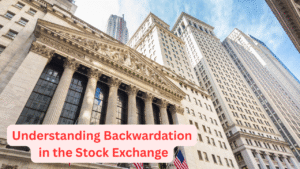 Understanding Backwardation in the Stock Exchange: A Detailed Guide
Understanding Backwardation in the Stock Exchange: A Detailed Guide
In the world of finance and commodities trading, the term backwardation frequently arises, especially in the context of futures markets. While it may sound technical or obscure to beginners, understanding backwardation is essential for anyone involved in or curious about trading, investing, or market dynamics. This article will explore backwardation in detail—its definition, causes, examples, and implications within a stock exchange or financial market scenario.
What Is Backwardation?
Backwardation is a market condition where the current price (spot price) of an asset is higher than the price of its futures contracts. In simple terms, it means that investors are willing to pay more for a commodity or asset now than they would for the same asset to be delivered at a future date.
This phenomenon typically occurs in commodities markets—such as oil, gold, or agricultural products—but it can also appear in financial instruments like stock index futures or exchange-traded funds (ETFs). When applied to a stock exchange context, backwardation usually reflects underlying market stress, tight supply, or a sudden surge in demand.
Backwardation vs. Contango
To better understand backwardation, it’s helpful to contrast it with its opposite—contango. In a contango market, futures prices are higher than the spot price. This is the more “normal” condition in most markets because of costs associated with storage, insurance, and interest over time.
In backwardation, however, the immediate need for the asset outweighs those costs, and buyers are willing to pay a premium to get it now. It’s often considered a sign of short-term scarcity or risk aversion in the market.
Causes of Backwardation in Stock Markets
Backwardation in financial or stock-based futures may arise for several reasons:
- High Current Demand or Low Supply
If investors or institutions urgently need to buy the underlying stocks or ETFs now, perhaps due to unexpected news, earnings reports, or market volatility, the spot price can surge, outpacing futures. - Dividend Expectations
Futures contracts on stock indices typically price in expected dividend payments. If a significant dividend is expected before the futures contract expires, the futures price may be adjusted downward to reflect that, creating a backwardated structure. - Interest Rate Changes
A sharp rise in interest rates could lead investors to prefer holding cash or other short-term instruments, reducing demand for future-dated contracts and pushing their prices below spot. - Hedging Pressure and Short-Selling
Institutional hedgers or speculators may short futures to offset risks in their stock portfolios. Heavy short interest in futures, especially during volatile periods, can suppress future prices relative to the spot. - Expiration Effects (Roll Yields)
In some ETF or derivative products, prices can fall into backwardation close to expiration as investors roll contracts forward, temporarily distorting price relationships.
A Stock Market Example of Backwardation
Let’s imagine the S&P 500 Index is trading at 4,500 today. However, a futures contract expiring in three months is priced at 4,480. This $20 difference shows a backwardated market. Why would this happen?
- Perhaps a global crisis has driven sudden demand for immediate liquidity, pushing up the spot price.
- Investors could be pricing in lower expected earnings or political instability in the near future.
- A significant dividend distribution might be anticipated in the interim, making the future price logically lower.
In such scenarios, market participants might choose to sell futures contracts and buy the actual index (or related ETFs) to profit from the price difference—this is known as arbitrage.
Implications
1. Indicator of Market Stress:
Backwardation is often seen during times of uncertainty or crisis. It reflects a situation where market participants value immediate ownership of assets more than delayed delivery.
2. Trading and Arbitrage Opportunities:
Traders can exploit backwardation by taking advantage of the price difference between spot and future contracts. For example, a trader might buy the asset and sell a future contract, expecting the prices to converge.
3. Impact on ETFs and Mutual Funds:
Funds that track commodities or use futures may experience roll gains during backwardation. As they replace expiring contracts with cheaper future ones, the fund can profit—unlike in contango, where they might lose money on each rollover.
4. Risk Management Considerations:
Portfolio managers use backwardation signals to adjust strategies. A backwardated index futures market may prompt increased caution or hedging.
Is Backwardation Always Bad?
Not necessarily. While it can signal short-term market stress, backwardation is not inherently negative. In commodities, it may encourage producers to sell inventory and meet demand. In stock markets, it reflects real-time sentiment and investor behavior.
Moreover, some active investors and hedge funds actually prefer backwardated markets due to the potential for positive roll yields, which can improve performance when futures are part of the strategy.
Final Thoughts
Backwardation may sound like a technical term buried deep in finance textbooks, but it plays a vital role in how modern markets function. Whether it’s oil prices, stock indices, or gold futures, the appearance of backwardation gives traders and investors insights into real-time supply-demand dynamics, investor psychology, and short-term market risks.
For stock market participants, especially those dealing in derivatives or ETFs, understanding backwardation is not just academic—it’s practical. It informs better decision-making, hedging, and timing strategies. As financial markets become increasingly complex and interconnected, knowing concepts like backwardation provides a valuable edge.
